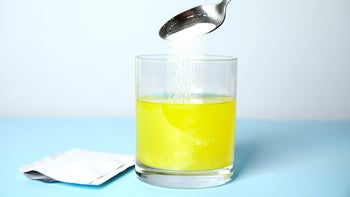
Stool Softeners vs. Laxatives: A Complete Guide to OTC Products for Constipation
Key takeaways:
Lifestyle changes — like adding fiber to your diet or exercising — can relieve constipation.
If lifestyle changes don’t work, there are many over-the-counter (OTC) products that can help.
OTC laxatives should only be used short-term. If constipation continues despite laxative use, contact your healthcare provider.

Constipation — typically defined as having fewer than three bowel movements per week — is a common complaint in healthcare providers’ offices. One study found that around 16% of U.S. adults experience constipation. And that number more than doubles for people ages 60 years and older.
Changing some of your daily habits is often all that’s needed. This includes getting more physical activity, drinking more water, and eating fiber-rich foods. If these changes don’t help, there are over-the-counter (OTC) stool softeners and laxatives that treat constipation.
Here, we’ll discuss the different categories of stool softeners and laxatives, and how to decide which OTC product is best for you.
Search and compare options
What OTC products can I use for constipation?
OTC constipation products include stool softeners and laxatives. One product may be preferred depending on what’s causing your constipation. It’s always best to talk to your healthcare provider or pharmacist about which constipation medication is best for you.
What’s the difference between a stool softener and laxative?
We often refer to stool softeners and laxatives as different medications. But stool softeners are actually a type of laxative called emollient laxatives. Laxatives are categorized based on how they work.
Below we’ll discuss stool softeners and the other categories of laxatives — osmotic, stimulant, saline, bulk-forming, and lubricant laxatives.
Stool softeners (emollient laxatives)
Stool softeners are used short-term to relieve occasional constipation. They help prevent straining during bowel movements.
Specific products
The most common OTC stool softener is docusate sodium. It’s also available under the brand names Colace, and DocQLace.
How do they work?
Stool softeners allow water and fat to build up in the stool, making it softer and easier to pass. This helps avoid straining during a bowel movement, which is especially important in people with heart conditions or hemorrhoids.
How long do they take to work?
You’ll usually have a bowel movement after about 12 to 72 hours upon using a stool softener. Don’t take stool softeners for more than a week at a time. If you’re still having hard stools after a week of using them, contact your healthcare provider.
Side effects
Stool softeners usually have minimal side effects. Rarely, they cause stomach cramps or a rash. The liquid forms may cause throat irritation, so it’s important to take it with water.
Laxatives
To treat constipation, most healthcare providers recommend adding fiber to your diet or trying a bulk-forming laxative. If this doesn’t work, osmotic and stimulant laxatives are often second-choice options. Other laxatives, like saline or lubricant laxatives, may be good options in certain situations.
Bulk-forming laxatives
Specific products
Bulk-forming laxatives are available as OTC products, including:
Calcium polycarbophil (FiberCon)
Psyllium (Metamucil)
Methylcellulose (Citrucel)
How do they work?
Bulk-forming laxatives add soluble fiber to the stool, causing more water absorption. This creates a heavier stool which encourages the colon to contract and eliminate the stool. You should drink a lot of water while taking bulk-forming laxatives. A lack of water can lead to complications with these medications, like a blockage in the intestines.
Healthcare providers will usually recommend you start with a small dose, and slowly raise it until you have regular bowel movements.
How long do they take to work?
Bulk-forming laxatives usually produce a bowel movement within 12 to 72 hours. If you’re still experiencing constipation after 7 days, contact your healthcare provider.
Side effects
Similar to other laxatives, bulk-forming laxatives can cause gastrointestinal side effects like bloating, diarrhea, and nausea.
People who can’t get out of bed, have fluid restrictions (like in heart failure), or who have issues with cognition should avoid bulk-forming laxatives.
Osmotic laxatives
Specific products
Osmotic laxatives are available as OTC products, including:
How do they work?
Osmotic laxatives allow water to be easily absorbed in the small intestine. This creates a softer and bulkier stool, making it easier to pass. One of the most commonly used osmotic laxatives is PEG. PEG is a first-choice option for constipation because it’s effective and usually doesn’t cause many side effects. Besides treating constipation, it’s commonly used to prepare the bowel before a colonoscopy.
How long do they take to work?
Oral PEG usually works within 1 to 3 days. Glycerin — a rectal suppository — usually takes 15 minutes to 1 hour to work.
Side effects
Osmotic laxatives usually have minimal side effects, but the most common are stomach pain, diarrhea, and nausea.
If you have kidney problems, talk to your healthcare provider before taking osmotic laxatives. They may monitor your electrolyte levels or recommend another laxative.
Stimulant laxatives
Specific products
Stimulant laxatives are available as OTC generic and brand name products, including Bisacodyl (Dulcolax) and Senna (Senokot, Ex-Lax).
How do they work?
Stimulant laxatives cause muscle contractions in the digestive tract. This allows the stool to move quickly through the intestines, resulting in more frequent bowel movements. Stimulant laxatives are usually recommended when osmotic laxatives don't work.
How long do they take to work?
Stimulant laxatives can produce a bowel movement in 6 to 12 hours if taken orally, and 15 minutes to 1 hour if given rectally.
Side effects
The following side effects can occur with stimulant laxatives:
Diarrhea
Stomach pain
Nausea
Vomiting
Headache
Saline laxatives
Specific products
Saline laxatives are available as OTC products, including:
Magnesium hydroxide (Milk of Magnesia)
Magnesium citrate (Citroma)
Magnesium oxide (Phillips’ Laxative Caplets)
Saline enema (Fleet enema)
How do they work?
Saline laxatives draw water into the bowel, leading to softer stool and more frequent bowel movements. All saline laxatives are some form of a salt, which naturally draws water. Sometimes they’re categorized as an osmotic laxative because they work similarly.
Saline laxatives work quickly and can be used to clear the colon before a colonoscopy.
How long do they take to work?
Saline laxatives usually work within 30 minutes to 6 hours. But an enema formulation can work in just 1 to 5 minutes. Contact your healthcare provider if you don’t have a bowel movement within 30 minutes of using a saline enema.
Side effects
Oral saline laxatives can cause loose and watery stools. The rectal enema formulation can cause:
Stomach pain
Bloating
Nausea
Chills
Lubricant laxatives
Mineral oil is the only OTC lubricant laxative. It’s available as a generic oral liquid or a rectal enema (Fleet Mineral Oil Enema.)
How do they work?
Mineral oil makes the surface of stools slippery, which helps them pass through the body more easily. It can be used rectally for constipation caused by impaction (a hard lump of stool that gets stuck in the rectum).
How long do they take to work?
Mineral oil usually works within 6 to 8 hours when taken by mouth, and within 15 minutes when used rectally.
Side effects
The following side effects can occur with mineral oil use:
Stomach pain
Strong urge to have a bowel movement
Nausea
Diarrhea
If mineral oil is accidentally inhaled into the lungs (aspiration), pneumonia can occur. Avoidmineral oil if you have difficulty swallowing.
Can you take stool softeners and laxatives together?
In some situations, your healthcare provider may recommend combining a stool softener and laxative. There's an OTC product that combines a stool softener (docusate) and a stimulant laxative (senna). It’s available under the brand names Senna-S, Dok Plus, or Senexon-S. It generally works within 6 to 12 hours.
You shouldn't take docusate and mineral oil together. This can cause too much absorption of the mineral oil.
Who shouldn’t take stool softeners or laxatives?
If you have kidney or heart issues, ask your healthcare provider before taking laxatives. Certain types of laxatives could make your kidney issues worse. Osmotic laxatives increase the amount of fluid in the body and could overload your heart.
Constipation is more common during pregnancy. Non-medication interventions — like increasing your fiber intake — should be tried first. Pregnant people should aim for 25g of fiber daily. If you need medication, your obstetrician may recommend bulk-forming laxatives, Milk of Magnesia, or stool softeners.
Avoid OTC laxatives and contact your provider if you have severe stomach pain, nausea, or vomiting along with constipation.
When should I call my healthcare provider?
Taking laxatives for too long can cause dehydration and electrolyte imbalances. Contact your provider if you’ve been taking laxatives for over a week with no improvement. You should also contact your provider if you vomit, have blood in your stool, or if you haven’t had a bowel movement in 3 days.
The bottom line
Changing your diet and exercising are often all that’s needed to treat constipation. But, if this isn’t enough, there are many different OTC treatment options for constipation. Talk to your healthcare provider or pharmacist to discuss which stool softener or laxative is best for you.
Why trust our experts?



References
American Academy of Family Physicians. (2020). Laxatives: OTC products for constipation.
American College of Gastroenterology. (2016). Constipation and defecation problems.
American College of Obstetricians and Gynecologists. (2020). What can help with constipation during pregnancy?
American Family Physician. (2005). Constipation.
American Pregnancy Association. (n.d.) Laxatives during pregnancy.
Bandla, H. P. R, et al. (1999). Lipoid pneumonia: A silent complication of mineral oil aspiration. Pediatrics.
Bashir, A., et al. (2021). Laxatives. StatPearls.
Bayer. (2021). Phillips’ laxative caplets.
DailyMed. (2017). Fleet-enema.
DailyMed. (2018). Humco Mineral Oil Heavy - mineral oil liquid.
DailyMed. (2019). Pedia-Lax — glycerin liquid.
DailyMed. (2020). Fleet glycerin suppository.
DailyMed. (2020). Miralax — polyethylene glycol 3350 powder, for solution.
DailyMed. (2021). BISAC-10 Bisacodyl stimulant laxative - bisacodyl suppository.
DailyMed. (2021). Citroma magnesium citrate liquid.
DailyMed. (2021). Citrucel — methylcellulose powder, for solution.
DailyMed. (2021). Fibercon — calcium polycarbophil tablet.
DailyMed. (2021). Laxative docusate sodium with senna — docusate sodium and sennosides tablet, coated.
DailyMed. (2021). Metamucil therapy for regularity — psyllium husk powder.
DailyMed. (2021). Senokot — standardized senna concentrate tablet.
DailyMed. (2021). Stool softener- docusate sodium capsule, liquid filled.
Fleet. (n.d.). Mineral Oil Enema.
Hannoodee, S., et al. (2021). Docusate. StatPearls.
International Foundation for Gastrointestinal Disorders. (2003). Laxatives.
Low, A. (2010). Treating constipation with laxatives. GI Society: Canadian Society of Intestinal Research.
MedlinePlus. (2017). Sodium phosphate rectal.
MedlinePlus. (2018). Stool softeners.
MedlinePlus. (2019). Magnesium citrate.
MedlinePlus. (2019). Magnesium hydroxide.
MedlinePlus. (2020). Constipation–Self care.
National Institute of Diabetes and Digestive and Kidney Diseases. (2018). Definitions & facts for constipation.
Schuster, B. G., et al. (2015). Constipation in older adults. Canadian Family Physician.
Sharma, A., et al. (2021). Review article: Diagnosis, management and patient perspectives of the spectrum of constipation disorders. Alimentary Pharmacology & Therapeutics.
Siegel, J. D., et al. (2005). Medical treatment of constipation. Clinics in Colon and Rectal Surgery.
Weinstein, M. (2001). First do no harm: The dangers of mineral oil. Paediatrics Child Health.
Xing, J. H., et al. (2001). Adverse effects of laxatives. Diseases of the Colon & Rectum.

























